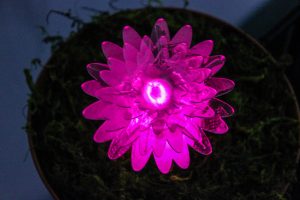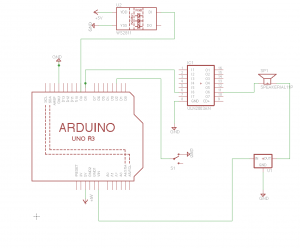Flower Power
Conlon, Nitesh, and Sydney
Submitted 12/7/2016
Video Link: https://www.youtube.com/watch?v=GHNPC9KZVsY

The finished product with all three glow flowers mounted and activated in the trellis.
- Abstract
For our project we created a set of acrylic “glow flowers” that light up and play music when plugged into pots. Our goal was to inspire wonder in children by having them be able to plug flowers into and remove them from pots, each with unique and different behaviors, bringing them to life in the process. We wanted each pot to feel distinct when activated by playing different chiptune-style songs and shining different shades of light through the flower via a multi-color LED in the pot and strands of fiber optic cable in the flower. Our project held up well during the museum visit and was mostly popular with younger children.
- Objectives
We programmed each of the three pots to have a range of colors (blue, green, and red respectively). The LED flashes a random color within the pot’s designated color range in time with the music playing through the pot’s internal speaker. We pre-programmed a small library of audio samples using the Arduino Tones library and transcribed short, identifiable sections of 8 different songs. They play back in a random order as long as a flower is plugged in, looping through the library as needed. Additionally, each pot played the songs at a different tempo, with blue being 25% slower, green being the “normal” default tempo of the tones library, and red being 25% faster. Finally, we included startup and shutdown sounds that play only when a flower is plugged in or taken out. These are programmed not to able to be interrupted or have their speed modified (read as: the tones are always identical no matter which pot is playing them) to make the associated “on/off” behavior more clear to the user via the audio queue.
- Implementation
The flower pots contain all of the electronics and wiring used in the project including an Arduino UNO, a speaker, and a multicolor Adafruit NeoPixel LED. We designed a system of acrylic spacers and a connector piece so that the bases of the flowers would be secure resting in the pots. Inserting a flower also pushes a switch that triggers the LED lighting and pre-programmed chiptune music.

A close-up of the LED illumination of the stem and the fiber optic strands’ illumination of the petals.
The flowers themselves were made from layers of laser-cut acrylic and a clear tube for a stem, through which we wired fiber optic cable strands to the “petals” of the acrylic flower between the individual layers of the blossom assembly. We also decided to create our own connectors to attach the flowers to the the pots. We based these off of basic lego design, as we believe children would understand that. We also used a real trellis and flower pots from Lowes along with modeling moss to create a more believable environment for our fake flowers. We wanted the flower to have many different refractive facets and have space for the fiber optic cables, so we decided to layer identical flower designs in descending size as it created a pleasing visual effect and to house the fiber optics. We also sanded the surface of these layers to create an effect similar to that of frosted glass.

A close-up of the layers of acrylic that make up the flower petals.
Additionally, we wanted to allow the children to plant and pluck the flower, which is detected by the pot via a standard mechanical switch. We wanted the children to receive positive feedback for planting flowers and so we made it so that when the flowers are plugged in, they light up and play music.
- Outcomes
Our project was set up at the end of the Attic in the Carnegie Children’s Museum. This allowed us to have a dark space to show off our glowing flowers but is also a fairly low traffic area. It was very successful with younger children especially those around 4 years old who were captivated by the colors and sound. On the other hand, many older children were only interested in it briefly and quickly moved on after they tried plugging the flowers once or twice. Initially, many adults originally thought our project was a non-interactive display, and would dissuade their children from touching or pulling out the flowers until we showed them how to use it. Children also had a tendency to pull the flowers out by their acrylic petals rather than the stem, which resulted in a couple of flowers coming apart. We were able to swap out the broken flowers with spares we had prepared until all of the flowers could be repaired and reinforced on-site.

Top view of the finished product with all three glow flowers turned on.
- Contribution
We each had a part of the project which we focused on (Sydney worked on hardware, Nitesh on fabrication, and Conlon on software), but we all collaborated and overlapped on a large majority of the project. Notable contributions headed up by each person include the design of the flower attachment adapter by Nitesh, the implementation of the music library and light behavior by Conlon, and the wiring and replication of the electrical circuits by Sydney.

Electronic Schematic
Full Code Zip File: flowersongandcolor
Full Code Link: https://drive.google.com/open?id=0B_kXzZBfZJ5dTXh6eXZudWJzVms
Leave a Reply
You must be logged in to post a comment.